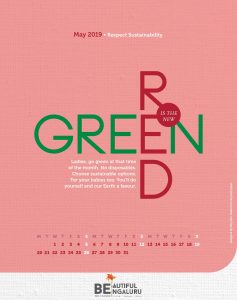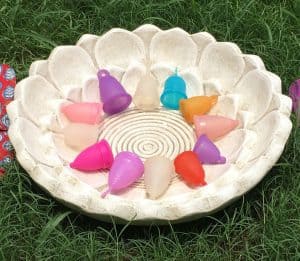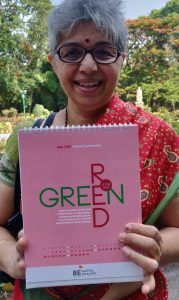As we observe World Menstrual Hygiene Day today, May 28th, I would like to share the contents of a somewhat private whatsapp message I got a few days ago. It said: Odette, so what exactly does sustainable menstruation mean? You may think, yes times are changing and people are beginning to open up on such subjects, not really a big deal. Well, let me add a bit more: the message was from a male. From a male I barely knew – we are on a common group, where right through this month, I have been sharing the May page of the Beautiful Bengaluru calendar across several groups, urging women to go green at that time of the month. He went on to add: How can I get my wife and daughter to start off, can you help?
Why is this relevant to share today, you may ask. Because World Menstrual Hygiene Day is intended to focus on millions of women worldwide without access to hygienic solutions during their monthly period. This particular day was chosen to represent a woman’s cycle at intervals of 28 days, usually lasting 5 days – hence 28/5! First commemorated in 2014 by the German NGO WASH United, today, its observance is critical to continue the focus, but with a changed track in the context of the global environment crisis.
We need to go beyond free sanitary napkins, and focus on sustainable options that do not generate waste. No more single-use disposables here either; just as we are doing away with plastic bags/bottled water and carrying our own bags/bottles, Bring your own cup – BYOC – works equally well here!
Breaking norms
A flashback to my past – growing up and even as an adult, I do not recall a single instance where periods were discussed in front of my father. In public, we used euphemisms like ‘the jam bottle’ so that males around wouldn’t catch on! Today my daughters happily sit beside their father, viewing choices of menstrual cups/ cloth pads online, making purchases after considered discussions!
Some may react to what I will share next as a case of TMI (‘too much information’), but there is a reason for going public. The subject was never discussed because it was considered taboo; so awareness continues to be low. Time for all that to change – we agree no subject is too dirty in the quest to keep our planet clean!
I first heard of the cup when I was ahem, well into what some consider menopausal age – I was 53. Deeply involved in my life’s goal of reducing waste to landfill, a small inner voice signalled I should try it. Another voice in my head promptly answered: are you crazy? Too late to check new-fangled trends for your few remaining periods. I rationalised: you wouldn’t buy brand new tyres for an old car with the engine about to cease, would you? An analogy that brings chuckles from those I’ve shared it with but perfectly drives home the point!
A few more months went by. Every time I met a cup-user, my guilt increased. With each passing period, the voice got louder. I had by then eliminated every other single-use disposable from my life, but this one weighed me down (and the belief that tampons are better than napkins doesn’t count either; both are non-biodegradable plastic). I give regular talks to audiences on sustainable living. I needed to walk the talk.
The voice continued: work with integrity of purpose, no room for double standards. Well, I eventually took the plunge. It’s been over a year now, that old engine is still chugging along, having adapted beautifully to the ‘new tyres’! I now continue to spread the no-waste message with zero guilt.
As most cup-users will tell you, it takes just a couple of cycles to adjust and then you never look back. It is deeply liberating. You are consumed by the immense benefits – for me the biggest was being zero-waste. I have witnessed male waste workers picking up unwrapped sanitary napkins from apartments bins and always wished sanitary waste could disappear – and now for me, it has! Then the convenience – you can do anything, swim, run, anything! It is private (no more sneaking off to the loo, pad in hand). You can go many hours without emptying. It is healthy (made of inert silicone, same as medical stents, not like plastics of disposable pads/tampons that cause rashes or worse, long-term intimate exposure to carcinogenic substances).
Yes, anyone can…
Back to my story – my home with 3 females now has zero sanitary waste, as part of our zero-waste philosophy (wet waste composted, heck even the cat’s poop is composted and BYOC ensures we barely have dry waste). Some months back, as I stood sterilising my menstrual cup (incidentally, gynaecologists confirm this is not needed; just washing well with water, not even soap, is sufficient), my maid showed interest and wanted to know what it was and how it worked. I explained the concept to her; she grimaced.
I worked on her and three months later, she switched! I’d shown her videos from this site: https://www.hygieneandyou.com/ (do check it too, it clarifies every doubt on the subject). My maid is now a delighted user, a ‘cupvert’ is the term, I believe! She is thrilled with the convenience (does regular overnight bus journeys), no waste/disposal problems, doesn’t spend every month (a huge benefit for lower income strata, but irrespective, a cost-saver long-term both directly/indirectly with likely reduced gynaecologist visits, I am told).
My intent in telling you the story in this much detail is that I too once believed this was not for me. If I could do it, anybody can. And everybody must!
Even my maid, who never imagined she’d ever shift to something like this, today helps influence other maids and contacts.
What this means is that the idea needs to be planted first for it to germinate and take root. Quite a few reporters have called me on this subject in the last few days. With each conversation, I know I have planted the seed with chance of few more cupverts! In writing this article, I hope I will influence a thousand more minds.
If you are a female and aren’t already a user, please do consider the shift. I strongly urge you to. This is the right time to rethink. If you think the cup is not for you, there are amazing colourful reusable quick-drying cloth pads as well that many are finding very convenient to use.
Not just a ‘woman thing’
If you are a male, please share this idea with your wife, daughters, sisters… Don’t underestimate the power you have to swing decisions, especially one as sensible.
Male or female, do take time to understand more from this video interview the Logical Indian did with Dr Meenakshi Bharath, reputed city gynaecologist and green crusader. No rash, no trash, no cash is well worth the shift!
As I shared before, I have been circulating the ‘Green is the new red’ poster many times this month on many groups, all with men on them. Two years ago, I would have hesitated. Today, I feel everyone is ready for this. My reading is correct. And the several messages I am getting from males means the seed of the idea is definitely taking root irrespective of gender!
Males too can be change-agents in this green revolution, helping us green our periods. There are campaigns called Green-the-Red, Period Love, Bleed Green…. All point to this one key message – shift to reusables, reduce your waste. The earth needs you to. Your body needs you to. Let’s heed the call, be the change and make a beginning. Every such shift breathes life back to our earth, much needed in today’s stressed environment.




Changes start from where inhibitions stop and inhibitions cease to exist at the point where one feels for the cause!
Not just a well-written article but a well-felt one, too!
Go for the change; Green the Red!
Informative and inspirational one. Such writings should also come out in regional languages.